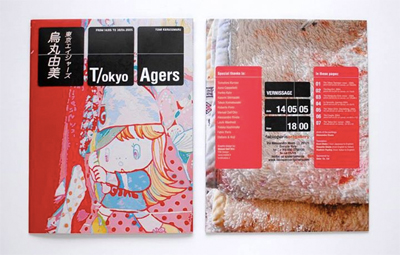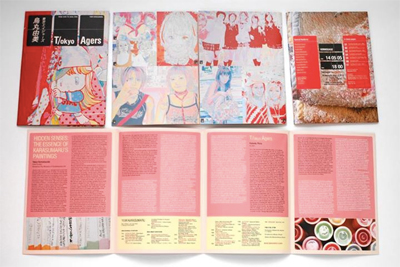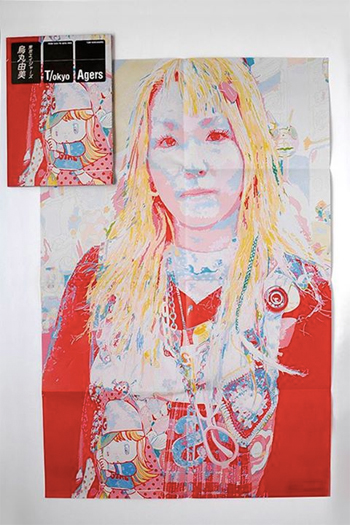From the catalog for the personal exhibition "T/okyo Agers" at fabio paris art gallery, Brescia, Italy 2005
- "T/okyo Agers"
Roberto Pinto (art critic)

One of the elements that typifies the artistic production of Yumi Karasumaru is the on-going link with her origins, with her country, Japan. Recollections, memories, personal and collective dramas, rites and habits, can be perceived in different ways in her paintings and performances. The distance she has drawn between herself and her birth place is a sufficient antidote against the errors of a vision which would risk being overly passionate and, therefore, unable to read its present. It is a measure that guarantees her sufficient space to become detached from the circumstances of daily life, but, nevertheless, allows her to reclaim - with a direct interested gaze - her roots and to 'expose' herself. Since '95 she began to paint a series of pictures about Hiroshima and Nagasaki. This was fifty years after that tremendous episode, perhaps too distant from our Europe to make us still reflect deeply enough about its meaning and the resulting drama, but an episode still very much alive in the minds of Japanese people. Through time, portraits of family groups and teenagers (who are also the subject of this exhibition) have alternated with those images. Once again in this new stage of her artistic path, Yumi Karasumaru shows us how the history of her country intertwines with the individual stories of the people who live there - happenings as real as the great events filling the pages of books and newspapers. Therefore, her works analyse a society which underwent modernisation and 'Westernising' of customs in an apparently soft way, but which, inside, may have suffered traumas deeper than they may seem. Perhaps a number is enough to describe this complex situation: 34,427, the total number of people who committed suicide in 2003 alone.
And we ought to mention that there are Sites suggesting the best ways of reaching this objective without suffering and that almost a hundred of these victims are elementary or secondary school students, we realise how all individuals, even the younger ones, are in trouble, and how difficult it is for them to respond to the different needs and expectations a society in crisis.
Through the youths who inhabit these pictures, we can probably see what has changed in this country (and, I should add, not only in Japan) in just the last few years. We can also perceive how, in the eyes of a person of a different age, that world is peopled by symbols, values, and rituals that make these young people seem almost like alien figures.
We can also use an analysis of the technique of the pictures, as a key to interpreting the works of Yumi Karasumaru: the pictures begin with photographic images, which the artist herself took in Japan, the result of chance meetings during which she always asked for permission to take those photos. The brief relationship established by the artist enables us to look these youths in the face, to meet their gaze. The technique itself is a refined solution of colour application (obtained from mixes she prepares herself to find the right tonality), which simulates the flatness of the computerised images and, at the same time, the weft of a piece of embroidery, in which Karasumaru newly seeks a continuous point of balance between emotional rush and detachment.
Of late, the white zones have broadened, making the picture more 'essential', without however overlooking the quest for the right distance between memories and daily life, between deep participation and enquiring gaze, between herself and others.
I tempi della rappresentazione
di Roberto Pinto
(critico d'arte)
Uno degli elementi caratterizzanti la produzione artistica di Yumi Karasumaru è la costante relazione con le sue origini, con il suo Paese, il Giappone. Ricordi, memorie, drammi personali e collettivi, riti e abitudini, entrano in modi differenti nei suoi quadri e nelle sue performance. La distanza che ha frapposto tra lei e il suo luogo natale è un antidoto sufficiente contro gli errori di una visione che rischierebbe di essere troppo appassionata e dunque incapace di leggere il proprio presente. È una misura che le garantisce lo spazio sufficiente per distaccarsi dalla contingenza della vita quotidiana, ma che le permette ugualmente di riappropriarsi, con uno sguardo diretto e interessato, delle proprie radici e di mettere a nudo se stessa. Dal '95 ha cominciato a dipingere una serie di quadri su Hiroshima e Nagasaki, a 50 anni da quell'episodio tremendo, forse troppo lontano dalla nostra Europa per riuscire a farci ancora riflettere con la sufficiente profondità sul suo significato e sul dramma che ne è conseguito, ma ancora così vivo in Giappone. A quelle immagini, nel corso del tempo, si sono alternati ritratti di gruppi famigliari e di teenager (che sono anche il soggetto di questa mostra). Anche in questa nuova tappa del suo cammino artistico, Yumi Karasumaru, ci mostra come la Storia del suo Paese si intreccia con le singolari storie delle persone che lo abitano, fatti reali quanto i grandi avvenimenti che riempiono le pagine dei libri e dei quotidiani. I suoi lavori sono, quindi, l'analisi di una società che ha subito la modernizzazione e l'occidentalizzazione dei costumi in modo apparentemente morbido, ma che al suo interno ha forse subito traumi più profondi di quanto possa sembrare in apparenza. Forse basterebbe un numero, 34.427, per descrivere questa complessa situazione, numero che corrisponde al totale delle persone che si sono suicidate nel solo 2003. Se a ciò si aggiunge che esistono siti in cui vengono suggeriti i migliori modi per raggiungere tale obiettivo senza soffrire, e che quasi un centinaio di queste vittime sono bambini di scuola elementare o media, ci possiamo rendere conto di quanto tutti gli individui, persino i più piccoli, si trovino in difficoltà, facciano fatica a rispondere ai differenti bisogni e alle aspettative di una società in crisi.
Probabilmente attraverso i ragazzi che abitano questi quadri possiamo vedere cosa è cambiato in questo Paese (e aggiungerei non soltanto in Giappone) solo negli ultimi anni e come agli occhi di una persona di una differente età, quel mondo si sia popolato di simboli, valori, rituali che fanno apparire questi giovani quasi come delle figure aliene.
Possiamo usare anche l'analisi della realizzazione dei quadri come una chiave ulteriore di lettura dei lavori di Yumi Karasumaru: i quadri partono da immagini fotografiche che l'artista stessa ha raccolto in Giappone, frutto di incontri casuali in cui sempre ha chiesto il permesso di scattare quelle foto. La breve relazione instaurata dall'artista ci permette di guardare in volto questi ragazzi, ci consente di coglierne lo sguardo. La tecnica stessa è una raffinata soluzione di stesura di colore (ottenuto da miscele che lei stessa prepara per trovare la giusta tonalità) che simula la piattezza delle immagini computerizzate e, allo stesso tempo, la trama di un ricamo, in cui Yumi Karasumaru cerca nuovamente un continuo punto di bilanciamento tra slancio emotivo e distacco. Ultimamente le zone di bianco si sono allargate rendendo il quadro più "essenziale", senza però perdere di vista la ricerca della giusta distanza tra memoria e quotidianità, tra profonda partecipazione e sguardo indagatore, tra se stessa e gli altri.

「トーキョー・エイジャーズ」
ロベルト・ピント(フリー・キュレーター、国立トレント大学芸術学部主任研究員)
烏丸由美の作品を特徴付ける要素の一つは、彼女の出生地であり母国である日本との絶えまないつながりである。彼女の絵画やパフォーマンスの中には、思い出、記憶、個人的なドラマや集団的な事件、しきたりや習慣などがさまざまな形で存在する。そこでは烏丸が日本へ帰国する度に、新しいイメージによって膨らむ現在が、さまざまな形で再び表面化する過去と— 痕跡がさほど明確でない作品においても — 見事に混ざりあっている。
彼女が自分自身と生まれ故郷との間においた距離は(烏丸由美は長年イタリアに住んでいる)、自身の過去の経験と変わりつつある社会のラディカルな変化との間に絶えまない刺激を作り出し、またもう一方では、情熱的なあまり、現実を読み取ることができなくなるという落とし穴に陥るのを防いでいる。言うなればこの距離は、自閉的な視点がもたらす歪みに対する有効な解毒剤になりうるのである。それは彼女を日常の出来事から引き離すために充分な空間を確約する方法である、と同時に、まっすぐで好奇に満ちた眼差しをもって自らのルーツをたどり、ありのままの自分自身をさらけ出すことをも可能にしている。
烏丸由美が広島と長崎をシリーズにした絵画を描き始めたのは、世界初の2発の原子爆弾の投下からちょうど50年後の1995年からである。その悲劇について、充分な深みを持って熟考するには、我々の住むヨーロッパはおそらくあまりにも遠すぎるだろう。実際、我々は、人類が初めて自らの手で地球上の生命を完全に抹殺する道具を手にしたという事実を、ほとんど忘れかけている。
時と共に、烏丸の描く対象は、こうした「痛み」のイメージから本展のテーマでもある家族やティーン・エイジャーの肖像へと移ってきた。その制作活動の新たな段階においても、烏丸由美は祖国の歴史を、そこに住む個々人のかけがえのない物語と絡めながら我々に提示する。個人の体験した出来事は、本や新聞のページを埋め尽くす大事件と等しくリアリティーを持つ。彼女の作品はつまり、表面的にはとても穏やかなかたちで習慣が近代化、西洋化されたように見えつつも、内面では想像以上に深いトラウマを被っている社会を分析する道具とみることができる。我々は、彼女の絵画の中に描かれた若者たちを通して、ここ数年の内だけでもこの国の何が変わったのかを見る事ができよう(これは日本だけのことではないことを付け加えておく)。
また、年配の世代の目には、こうした若者がまるでエイリアンと映るくらいに、この世界にはさまざまなシンボルや価値観、しきたりが存在することに気付く。烏丸と同世代の人々ももちろん、出始めたばかりの初歩的なビデオゲームで遊び、マンガを読んできた。現代の若者の多くにとっては、それらが現実に代わる世界を提供し、刹那的な世界の縮図として捉えられたが、彼らにはそのような存在になることはなかった。
この複雑な状況をあらわすには、34,427人 — 2003年度の日本における自殺者の総数— という数字ひとつで充分だろう。さらに付け加えるならば、苦しまずに自殺を達成する最良の方法を助言するウェブ・サイトがいくつもあり、この犠牲者のうち約100人は小学生と中学生である。こうした数字を通して、我々は若者を含むすべての個人がいかに苦悩しており、この危機に瀕した社会のさまざまな要求や期待に応えるのがいかに難しい事であるかに気付かされる。
絵画の制作過程もまた、烏丸由美の作品を理解する上で、ひとつの有効な鍵となる。作品は彼女自身が日本での偶然の出会いの中で、許可を得ながら撮影し、集めた写真像がベースになる。作家が若者たちとの間に築いたつかの間の関係の中から、彼らを正面から見つめ、その眼差しを読み取ることが許されるのである。作家は日常の出来事やニュースについて、大げさな表現やセンチメンタリズムを排してクールに語ろうとする。まず、理解しようとするのだ。こうして烏丸は、自らのシンボルと表象の形態を必死で追い求めるティーン・エイジャーの世界に、我々が彼女の眼とイメージを通して思いを巡らせ、入っていくことを可能にする。
烏丸由美の絵画とパフォーマンスで使われるテクニックは、この世界を解釈し、 解読するヒントを与えてくれる。絵画は実際、手の込んだ彩色(最適の色調を出すために彼女自身が混合した絵の具によるもの)により、コンピュータ処理されたフラットなイメージ、あるいは刺繍の横糸をシミュレーションしている。
一方、パフォーマンスは芝居を思わせる確かな構成を持ち、一人称で悲劇的な物語を語る。そして我々にその状況を理解させようとし、物語の再生をめざしている。それはしかし、同時に、伝統的な旧来の表象方法にしたがっているようにもみえる。
明らかに相反するこれらのテクニックであるが、作家の苦悩と努力の上に立って共に「思い巡らす」時間を掘り下げた結果である(作品に写真を直接使用する方がいかに簡単であるか考えてみよう)。それは烏丸に感情的な衝動と感情からの離脱、記憶と日常、深い感情移入と探究者の眼差し、そして自分自身と他者、それぞれとの間に均衡を見い出すことを可能にする時間なのである。

